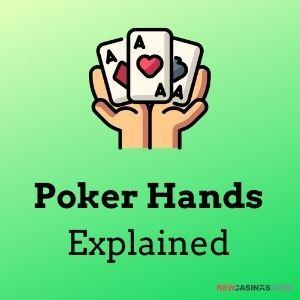What are the Odds in Poker?
Poker odds tell you how likely hands are to win in certain scenarios, but that’s just the tip of a much larger iceberg. In reality, odds are the foundation of poker, and moreover, they inform almost every decision you make.
I’ll get into the specifics throughout this guide. What I’ll say right now, however, is that poker odds govern how you choose starting hands, how you size your bets, how you make reads, and when you call, fold, or raise.
The reality is that poker odds are the framework within which all decisions should be made. That’s why they’re so important, and it’s the reason why you have to know how to calculate odds in poker.
Understanding Poker Odds
You can only make informed decisions if you understand poker odds. As I’ve said, odds are the foundation on which virtually all poker strategy decisions are based. Within this foundation are four pillars you need to understand:
1. Hand Odds
Hand odds tell you how much equity one set of cards has vs. another in a given situation. Most players start their journey into the mathematics of poker by looking at hand vs. hand odds using a calculator. I’ll show you how to use a poker calculator later in this guide. What’s important to know about these odds is that they give you a general understanding of the hands you should be playing.
For example, pocket aces have approximately an 85% chance of winning heads-up against a random hand. Based on this, you know statistically that aces are a strong starting hand.
2. Equity
Equity in poker refers to your theoretical share of the pot based on your chances of winning the hand. It’s a “theoretical” share of the pot because you can’t cash out your equity in the middle of a hand. Therefore, we can only say that you’ll win this much over time based on the strength of your hand. Calculating poker equity is simple. All you need to know is the size of the pot and the strength of your hand vs. an opponent’s hand.
For example, if your hand has a 60% chance of winning at a showdown and there’s £100 in the pot, your equity is £60 (i.e. 60% of £100).
3. Pot Odds
Pot odds refer to the cost of calling vs. the amount you stand to win. You use pot odds to determine how often a call must be right for it to be profitable. Put another way, pot odds allow you to determine how much equity you need to continue in a hand.
For example, let’s say the pot is laying you 3/1 on a call. This means you need to pay 1/3 of the pot, i.e. 33%, to call. I can use 33% as our equity benchmark. In other words, you need 33% equity or greater to make a profitable call. I’ll explain how to calculate pot odds in the next section. For now, just be aware that you can use pot odds to determine the equity you need against an opponent’s range to call.
4. Implied Odds
Implied odds in poker tell you the amount you stand to win if certain conditions are met. In other words, you’re calculating what you can win on future streets based on the amount of money in the pot and the size of an opponent’s stack. Implied odds are most commonly used when you’re drawing.
For example, let’s say you’ve flopped a flush draw in Hold’em: 9 cards can make your flush, and you have two streets to hit. From this, you can look at the amount you have to call and the amount of money an opponent has in their stack. Finally, you can put these variables together to decide how much you could win if a flush hit. There is, of course, a certain amount of guesswork in these calculations because you don’t know exactly how much an opponent will call on future streets. That being said, you can get a general idea of what you could win and whether it’s worth calling the current bet.
How Do I Calculate Odds in Poker?
There are various ways to calculate odds in poker, depending on the information you need. I’ve already shown you have to calculate equity, but you’ll need to know hand odds to do that. Similarly, if you want to calculate implied odds, you need to know how to calculate hand odds and pot odds.
You can use a poker calculator for pre-flop hand odds, as we’ll explain in the next section. However, if you’re in the middle of a hand, you can use a shortcut known as the rule of 4 and 2.
The Rule of 4 and 2 for Quick Odds Calculation
The quickest way to calculate your equity is the rule of 4 and 2. As the name suggests, you need to multiply your outs (i.e. cards you can hit to complete a draw) by 4 and 2. Here’s an example to illustrate how the rule of 4 and 2 works in poker:
- You have K♦ J♦
- The flop is 4♦ 6♦ 10♠
You have a flush draw to diamonds at this point. Based on what you know (i.e. the cards you’ve got), we can assume that there are 9 diamonds left in the deck. Why? Because there are 13 cards per suit.
We can multiply this number by 4 on the flop to work out how often you’ll hit a flush, i.e. how much equity you currently have in the hand. So, in this situation, you have approximately a 36% chance of hitting a flush (9 x 4 = 36).
Let’s say you call a bet, and the 2♣ lands on the turn. The board is now 4♦ 6♦ 10♠ 2♣, which means you’ve only got one chance to hit your flush. At this point, you can multiply your outs by 2. This means you’ve got an 18% chance of hitting your flush on the river (9 x 2 = 18).
Pot Odds
Once you’re able to count your outs and calculate equity in a hand, pot odds are the next concept you need to grasp. As we’ve said, pot odds give you the minimum amount of equity required to make profitable calls.
For clarity, pot odds can be used to make pre-flop and post-flop decisions. Let’s start with the basic formula for calculating pot odds:
- Step 1: Calculate the pot size if you were to call the current bet, e.g. £10 in the pot + £5 = a pot size of £15.
- Step 2: Divide the amount you need to call by the size of the pot. Using the above scenario, you need to divide £5 by £15 = 0.33.
- Step 3: Multiply the result from Step 2 by 100 to get a percentage. So, in this scenario, you have pot odds of 33%, i.e. 0.33 x 100.
Once you’ve calculated the pot odds, you can look at your assumed equity in the hand to decide whether or not a call is profitable. Here’s how you’d do this pre-flop and post-flop:
Pre-Flop
- You hold A-K
- Based on your reads, you think your opponent’s range consists of A-A to 7-7, A-K to A-10, K-Q, K-J, Q-J, and 8-9, 9-10, J-10.
- You can plug this range into a poker calculator, such as Equilab, to see what equity A-K has against this range. Using the calculator, we can see that A-K has 60% equity against the opponent’s range.
Based on this, we can say that you need pot odds of at least 60% to profitably call.
Post-Flop
- You hold A-K
- Based on your reads, you think your opponent’s range consists of A-A to 7-7, A-K to A-10, K-Q, K-J, Q-J, and 8-9, 9-10, J-10.
- The board: A 7 8 J 10
We can input your hand, the opponent’s assumed range, and the board to calculate the equity in this scenario. As shown in the image below, A-K has 34% equity with a pair of aces against the opponent’s range. That means the opponent’s range has almost 66% equity.
Therefore, based on this, you’d need pot odds of at least 34% to call.
Poker Odds Calculator
As you can see from our breakdown of equity and pot odds, there are a lot of variables to consider when you’re running simulations (aka calculations) in poker. With this in mind, let’s talk about the different types of poker calculators you can use and how they work.
How Does a Poker Odds Calculator Work?
A poker calculator tells you the equity hands have against each other in specific scenarios. A basic poker calculator looks at pre-flop situations and the probability of each hand winning by showdown. It does this by running thousands of showdowns to give you a percentage value.
For example, let’s say you put A vs. 2-2 in an all-in showdown. Based on all the possible combinations of community cards, A-A wins a showdown approximately 81% of the time. The exact figure can vary depending on the exact cards.
For example, Ad As has an 82% chance of winning against Ad 2s because they share suits. Ad As has 81% equity against 2c 2h because they don’t share suits. This gives 2c 2h some extra outs to a flush.
You can also look at the equity of hands after the flop, the turn, and on the river. Then, if you want to get more advanced, you can use a poker calculator such as Equilab to compare ranges. That means you don’t have to know what specific hand an opponent has. Instead, you can give them a range of hands and see how that compares to your holding.
Using a Poker Calculator
Now you know how poker calculators work, here are the 5 steps on how to use one:
- Decide whether you want to analyse a pre-flop or post-flop situation.
- Enter your hand.
- Enter your opponent’s hand or the range of hands you believe an opponent has.
- Run the calculation to see what your equity is.
- Think about how this equity will influence your decision. For example, if the pot odds don’t give you enough equity to call, there are two possible options: fold or raise. You can fold if the opponent is likely to call a raise. However, if the odds of getting a bluff through are high, go for the raise.
Issues With a Poker Calculator
Poker odds calculators are great but don’t rely on them to give you answers for every situation. Indeed, mathematics is an important part of poker, but it’s not the only part of the game. We’re not robots, which means we’re prone to mistakes, illogical decisions, and emotional swings. Therefore, you can’t always play the numbers.
Some of the issues with using a poker calculator are:
Real-Time Usage
You can’t use poker odds calculators in real-time. There are no rules against using them online or in a live setting. However, it’s simply not practical. It takes too long to enter a player’s possible range and get the answer you need. What you should do instead is use poker calculators away from the table. Analyse the hands you’ve played to get an idea of what the odds are in common situations. For example, if you’ve got A-K pre-flop and put your opponent on a standard opening range (like the one we previously described), you can assume you’ve got around 60% equity pre-flop.
Humans Make Mistakes
You can’t account for people making the right decisions every time. What’s more, determining a player’s range isn’t an exact science. You might think that a player’s range consists of AA-77, A-K to A-J, and K-Q. However, in reality, they could have bluffs in there and some odd hands, such as J-9. Even a small mistake in determining someone’s range can affect your calculation. So, while it’s important to use poker calculators, you can’t base your decisions entirely on the results they provide.
Operating Without a Poker Hand Calculator
Poker hand calculators should be an integral part of your arsenal, but, as we’ve said, you can’t rely on them completely. The best way to use calculators is as a study aid. Run through hands away from the table so you have an internal database of odds you can draw from when you need to.
Once you’ve done that, combine poker odds with reads on players, psychology, and tactics. For example, let’s say the pot odds are 25%, and your hand has 20% based on the range you’ve given an opponent. Poker maths, in this situation, states that you should fold. However, this doesn’t take into account psychology, table image, and game dynamics.
How to Think Holistically About Poker Hands
Let’s take the above scenario and add in some additional variables:
- You’re on the bubble of the $10,000 (around £8,000) WSOP Main Event
- Your opponent is a tight amateur
- People have only seen you showdown strong hands
I’ve already established that calling is mathematically incorrect because you don’t have enough equity. Based on this variable alone, folding is the correct play. However, when you factor in the other variables, raising might actually be better than folding.
Why? Because it’s a high-pressure situation against a player who is likely trying to make it into the money. This gives you a lot of fold equity which, potentially, could make raising as a bluff more profitable than folding.
Variables to Consider
This example is exactly why I’ve described poker odds as the foundation for decisions. It gives you a base to work from, but poker maths can’t give you the full answer. So, to conclude this section, here’s a checklist of variables to consider when you’re making decisions:
- What is your equity?
- What are the pot odds?
- How big is your stack and your opponent’s stack?
- What are the table dynamics?
- Are there any reads that might affect how your opponent has played/how you should play?
Maths and Poker
By now, you should realise that maths and poker are inseparable concepts. You can’t be successful in poker without an understanding of odds, probabilities, and equity. With this in mind, let’s delve deeper into the mathematics of poker.
What Kind of Maths is Used in Poker?
Other than the concepts I’ve already explained, you need to understand the following mathematical principles in poker:
- Hand combinations
- Bet sizing
- Expected Value (EV)
How to Use Maths to Win at Poker
Here’s how to use maths in poker to analyse ranges, size your bets, and make profitable long-term decisions:
Combinations: Analysing an Opponent’s Hand Strength
I’ve talked a lot about making decisions based on an opponent’s range, but how do you decide which hands someone could have? Having a read on the player matters. If they don’t play many hands, you can assume their range is fairly small. Conversely, if they play a lot of hands, you can assume they have a wide range.
In addition to reads, you can use combinatorics to get a general overview of what players could have. Basically, you can think about what someone is likely to have based on the odds of being dealt certain types of hands pre-flop.
You can be dealt 1,326 possible hand combinations ranging from pocket aces to 3-2 offsuit. These combinations break down in the following ways:
- 16 combinations of every unpaired hand i.e. you can be dealt 3-2 in 16 different ways.
- 12 combinations of unpaired offsuit hands, i.e. you can be dealt 5-6 offsuit in 12 different ways.
- 4 combinations of suited hands, i.e. 5h 6h, 5c 6c, 5s 6s, 5d 6d.
- 6 possible combinations of each pocket pair, e.g. Ah As, Ah Ad, Ah Ac, Ad As, Ad Ac, Ac As
As you can see, you’re much more likely to be dealt a random hand such as 6-8 than a pocket pair. Therefore, you can take this into account when you’re assigning ranges.
Bet Sizing: Pot Odds, Implied Odds, and Fold Equity
Pot odds and implied odds aren’t just for calling. You can use them to decide how much you’re betting. For example, if you think someone is drawing to a flush, you can deny them correct pot odds by making a large bet.
Another variable to consider is fold equity. This variable looks at how often someone will fold to bet rather than call or raise. For example, if you believe someone will fold 40% of the time and there’s £100 in the pot, you have 40% fold equity. You can use this number to size your bets accordingly, i.e. if there’s a small chance someone is going to fold and you want to bluff, make a big bet.
What is the Most Important Maths in Poker?
The most important mathematical concept in poker is Expected Value (EV). It’s the most important because it’s the result of every decision you make. Therefore, it’s the product of all the mathematical moves you make during a game.
💡The definition of Expected Value (EV) in poker is: “the total return of your decisions over time.”
The aim of poker is to make more positive Expected Value (+EV) decisions than negative ones. The caveat here is that +EV decisions don’t always result in positive results. You can correctly call an opponent’s bluff on the flop and lose when they hit a one-outer on the river. You need to ignore results like this.
The only thing we can do as poker players is make as many +EV decisions as possible and ignore the money you win or lose in a single hand. Why? Because variance (aka luck) swings in both directions. However, over time, results converge around the EV. Put simply, luck evens out, and if you’ve made more +EV decisions than -EV decisions, you’ll be ahead.
Most Common Odds in Poker
Here’s a quick overview of the most common drawing hands in poker and the odds of hitting on the turn or river. As I’ve discussed, the pot odds should justify a call. For example, if you’ve got 32% equity on the flop, you need pot odds of 32% or greater to call.
Drawing Hand | Number of Outs | Odds of Hitting After the Flop | Odds of Hitting After Turn |
|---|---|---|---|
Set (when you have a pair) | 2 | 8% | 4% |
Open-Ended Straight | 8 | 32% | 16% |
Inside Straight | 4 | 16% | 8% |
Flush | 9 | 36% | 18% |
Full House (with two pair) | 4 | 16% | 8% |
Straight Flush | 1 | 4% | 2% |
Poker Odds FAQs
I’ve tried my best to create a simplified guide, but I know that learning about poker odds can be overwhelming. If anything is unclear, feel free to contact me, and I will help as best I can. Below, I’ve also prepared a list of the most asked questions about poker odds.
What is the 4 and 2 rule in poker?
The rule of 4 and 2 allows you to calculate your chances of hitting a draw on the turn or river. You multiply your outs by 4 to get the odds of hitting a draw after the flop, and you multiply by 2 after the turn. For example, if you’ve got eight outs after the flop, you’ve got a 32% chance of hitting by the river, i.e. 8 x 4.
What are the odds of making a set in poker?
The odds of hitting a set on the flop after being dealt a pocket pair is 11.8%. After the flop, you’ve got an 8% chance of hitting by the river. Finally, you’ve got a 4% chance of hitting after the turn has been dealt.
What is the 10/20/30 rule in poker?
The 10/20/30 poker rule gives you a quick way to determine if a call is profitable with pairs, suited connectors, and unsuited connectors. Specifically, you need to be able to win 10x the bet if you have a pair and are chasing a set. You need to win 20x if you’re chasing a draw with suited connectors and 30x with unsuited connectors.
What is the 80/20 rule in poker?
Also known as the Pareto principle, the 80/20 rule in poker states that approximately 80% of your profit will come from 20% of your opponents. Therefore, you should focus on making the best decisions against a small selection of players rather than playing a lot of hands against a lot of players.
What is the best poker odds calculator?
Equilab is one of the best free poker odds calculators online. Other poker calculators worth downloading are Enterra, Poker Easy Odds, PokeRanger, and Intellipoker Calculator.
Should I use a poker odds calculator?
Yes, you should use a poker odds calculator to get a general understanding of how hands match up, as well as the probability of making draws. Once you’ve done that, you can use poker calculators to work out your equity in hands and whether you should call, fold, or raise.
What software do poker pros use?
Pros use a variety of poker tools to build up a better understanding of odds, equities, and Game Theory Optimal (GTO) decisions. Some products you should consider investing in are Holdem Manager, PokerTracker, PokerSnowie, GTO Wizard, and the Equilab poker calculator.
What is the best AI tool for poker?
PioSolver and Simple Postflop are AI-powered poker tools that allow players to run simulations. These simulations take into account a variety of variables and provide mathematically optimal results for specific scenarios.
Daniel Smyth has been engrossed in the industry for the past 17 years, leveraging his English degree and love for poker into a booming career. His unique insights and engaging writing style, alongside his years of experience, make him a trusted name in the industry.

Fact-Checked by Dhalia Borg, Head of Content

14 minread












